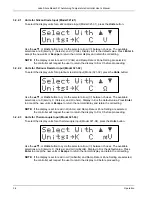
Lake Shore Model 321 Autotuning Temperature Controller User’s Manual
2-4
Installation
2.7 SENSOR
INSTALLATION
Abbreviated sensor installation recommendations for the Model 321 are included in this paragraph.
Please refer to the Lake Shore Product Catalog or Sensor Guide for installation details and sensor
specifications. Call Lake Shore for copies of application notes or with questions or comments
concerning sensor installation. The following are general recommendations on sensor installation:
1. Do not ground the sensor.
2. Shield the leads and connect the shield wire to SHIELD on the screw terminal connector only.
Do not connect shield at the other end of the cable.
3. Keep leads as short as possible.
4. Use twisted-pair wire. Use of Lake Shore Duo-Twist™ wire (or equivalent) for two-wire, or Quad-
Twist™ wire (or equivalent) for four-wire applications, is strongly recommended.
5. Lead wires should be thermally anchored.
Sensor installation is provided in two parts. Diode (Model 321-01) and Platinum (Model 321-02) sensor
connections are detailed in Paragraph 2.7.1. Thermocouple (Model 321-04) sensor connections are
detailed in Paragraph 2.7.2. Finally, sensor input error messages are described in Paragraph 2.7.3.
2.7.1 Diode (Model 321-01) and Platinum (Model 321-02) Connections
The Model 321 has a rear panel 6-pin input connector for silicon diode (Model 321-01) or platinum
resistance (Model 321-02) sensors. The lead connections are defined in Table 2-1.
Table 2-1. Diode or Platinum Input Connections
Terminal Description
1
2
3
4
5
6
– Current
– Voltage
+ Current 500 µA (platinum)
+ Voltage
+ Current 10 µA (diodes)
Shield
Paragraph 2.7.1.1 discusses two-lead versus four-lead measurements. Paragraph 2.7.1.2 discusses
connecting leads. Sensor mounting is covered in Paragraph 2.7.1.3. Finally, Paragraph 2.7.1.4
describes the effect of measurement errors due to AC noise.
2.7.1.1
Two-Lead Versus Four-Lead Measurements
The use of a four-lead connection is highly recommended for two lead resistive elements and
diodes to avoid introducing current/resistive (IR) drops in the voltage sensing pair which translates
into a temperature measurement error. In the two lead measurement scheme, the leads used to
measure the sensor voltage are also the current carrying leads. The resultant voltage measured at
the instrument is the sum of the temperature sensor voltage and the IR voltage drop within the two
current leads. Since in a cryogenic environment, the flow of heat down the leads can be of critical
concern, normally wire of small diameter and significant resistance per foot is preferred to minimize
this heat flow. Consequently, a voltage drop within the leads can be present.
1. Two-Lead
Measurements
Sometimes system constraints dictate the use of two-lead measurements. Connect the positive
terminals (V+ and I+) together and the negative terminals (V– and I–) together at the
instrument, then run two leads to the sensor.
I+
V+
I
V
Two-Lead
Measurements






























